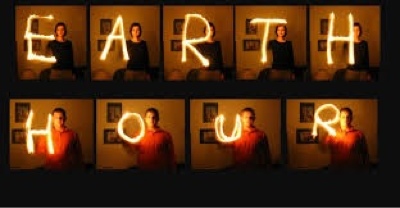1. What is Earth Hour?
Earth Hour is a global movement uniting people to protect the planet. Towards the end of March every year, Earth Hour brings together communities from across the world celebrating a commitment to the planet by switching off lights for one designated hour.
2. When does Earth Hour take place?
Earth Hour 2013 will be held on Saturday 23 March between 8.30PM and 9.30PM in your local time zone.
3. What does Earth Hour aim to achieve?
Earth Hour aims to encourage an interconnected global community to share the opportunities and challenges of creating a sustainable world.
4. What does Earth Hour ask people to do?
Earth Hour encourages individuals, businesses and governments to show leadership on environmental solutions through their actions, to use Earth Hour as a platform to showcase to the world what measures they are taking to reduce their environmental impact. Earth Hour asks everyone to take personal accountability for their impact on the planet and make behavioural changes to facilitate a sustainable lifestyle. Taking the first step is as easy as turning off your lights. By switching off your lights for Earth Hour you are acknowledging and celebrating your commitment to do something more for the planet that goes beyond the hour.
5. Is the campaign more than just lights out?
Earth Hour believes that the symbolism of the hour is incredibly important in bringing people and communities together across the globe. But our aspiration from the beginning was to go far beyond the hour itself. In 2012, Earth Hour launched I Will If You Will, a platform to incentivise and inspire individuals to share their commitment to the planet with their friends, colleagues, leaders and networks. Earth Hour also encourages and promotes many other initiatives around the world, including the Earth Hour City Challenge, the Earth Hour People’s Projects and many national and local actions that take the campaign beyond the hour.
6. How long has Earth Hour been going for?
Earth Hour 2013 will mark the seventh year of the campaign. On March 31 2007, WWF-Australia inspired Sydney-siders to show their support for climate change action. More than 2.2 million individuals and 2,000 businesses turned their lights out for one hour in the first Earth Hour event.
7. Isn't switching the lights off dangerous? What about public safety?
Earth Hour only asks people to turn off the non-essential lights for one hour - not lights that affect public safety. Earth Hour is also a celebration of the planet so it’s important to enjoy the moment in a safe environment.
8. What lights can be safely switched off?
That is a decision that has to be made individually but usually the overhead lights in rooms (whether it is your house or a business), outdoor lighting that does not impact safety, computers, decorative lights, neon signs for advertising, televisions, desk lamps, the list goes on and on. There are a few lights we can say with certainty that should NOT be turned off, including safety lights in public spaces, lights for aviation guidance, traffic lights, security lights, just to name a few. We ask people to use common sense. Before you turn off any lights for public spaces Earth Hour recommends you check with local officials or community centres. In your own home, use common sense with respect to safety. Keep small night lights on for basic safety especially in halls and on stairs. Make sure you have alternative light sources handy before Earth Hour starts, like torches or flashlights. That way if you need to see, you have a light source close at hand, and you can still respect the spirit of Earth Hour and keep yourself and your family safe.
9. What candles should I use for my Earth Hour event?
If you plan on burning candles during Earth Hour, make sure you use 100% beeswax candles or soy candles, which are gentler on our planet - smoke free, non-toxic and non-allergenic. They are also made of natural products, not petroleum-based materials, so they are effectively carbon neutral (the CO2 they emit has already been taken from the atmosphere to produce the wax). If you're using candles, though, make sure you take care. We suggest you carefully follow these tips: • Candles should only be used under adult supervision • Candles should never be left unattended • Candles should be kept away from children and pets • Extinguish candles before going to sleep • Keep candles away from flammable liquids and gas-combustible materials • Candles should be kept clear of any combustible materials such as paper, curtains and clothing • Candles should not be placed in windows as they can be blown over. Blinds and curtains can also catch alight • Candles should be placed on a stable, dry, heat-resistant surface away from drafts
10. What is Earth Hour's position on safety?
Earth Hour wants everyone to be absolutely safe and never to turn off any lights or power that would in any way compromise the safety of any individual in a private or public space. So please put safety first when deciding what lights to turn off during your participation. For Earth Hour’s broader I Will If You Will campaign, we will not support challenges that are not safe, not responsible or not respectful. So if it is dangerous, damaging or defamatory please think of others and think of something else for your challenge. We don’t encourage or endorse irresponsible behavior. Remember! Positive for the planet, not negative for life or limb.
11. Will my city go completely black?
Earth Hour is not a black out. It is a voluntary action by its participants to show their commitment to an act of change that benefits the planet. For many businesses in city skyscrapers or for many government buildings, the lights are turned off at the end of the business day the Friday before Earth Hour. So Earth Hour is more of a fade-out in some ways than a black-out. There is usually no instant dramatic difference, but rather a gradual dimming of lights starting the day prior. Many major icons and neon signs are switched off for the hour and they are extremely noticeable. You may be able to see dramatic changes in large business districts or at iconic landmarks and buildings around the world and in your city.
12. If everyone turns their lights back on at the same time will there be a power surge?
People celebrate Earth Hour in a variety of ways for different lengths of time, with many continuing to keep their lights off well beyond the designated hour. Therefore, it is highly improbable that everyone will switch their lights back on simultaneously. However, we do work with energy companies and authorities around the world, who assure us that the unlikely scenario of all lights turning back on at the same time will not cause any issues. The load reduction should not be significant enough to disrupt supply post Earth Hour.
13. Is Earth Hour an annual event?
Earth Hour is more than annual event, however it culminates in an hour of inspiration held across the world towards the end of March each year.
14. Why is Earth Hour held in late March?
The second-to-last and last weekend of March is around the time of the Spring and Autumn equinoxes in the northern and southern hemispheres respectively, which allows for near coincidental sunset times in both hemispheres, thereby ensuring the greatest visual impact for a global ‘lights out’ event. Earth Hour 2013 will be held on Saturday 23 March between 8.30PM and 9.30PM in your local time zone.
15. How many cities/countries/landmarks took part in Earth Hour 2012?
Earth Hour 2012 took place in more than 7001 cities and towns in 152 countries and territories across all seven continents. Hundreds of millions of people switched their lights off for an hour, and the campaign experienced its biggest growth since 2009.
Source



No comments:
Post a Comment